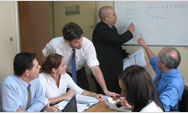Democracy and Governance in Somalia
The Development Challenge: Since the overthrow of Siad Barre in 1991, Somalia has lacked a central government and has been divided into a myriad of different fiefdoms controlled by rival warlords, who occasionally clash for territory. The current Transitional Federal Government (TFG) is based in Kenya. There have been numerous failed attempts at reconciliation; however, the most recent peace process led by the Intergovernmental Authority on Development (IGAD) in Kenya has achieved several major breakthroughs. A president, Abdullahi Yusuf Ahmed, was elected in October 2004 in Kenya by members of the transitional parliament, prime minister, Ali Mohamed Ghedi, was appointed in November, and a cabinet was confirmed in January. The present challenge is for the new government to relocate from Kenya and to establish security, legitimacy and acceptance. The threat of terrorism is central to international interest in Somalia. Maintaining livelihoods and a minimum level of health is a constant challenge to the population of Somalia. Infant and under five child mortality rates are among the highest in the world at 133 and 225 per 1,000 live births respectively. Somalia also reports one of the highest maternal mortality rates in the world with an estimated rate of 1,100 deaths per 100,000 caused by poor antenatal, delivery, postnatal care and limited obstetric facilities. An alarming humanitarian crisis is developing, triggered by the cumulative effects of successive poor rains, the deteriorating food security situation and civil conflict. Some 1.2 million vulnerable Somalis in both agricultural and pastoral areas currently require humanitarian assistance. The cyclical drought affecting the north, the worst experienced in over 30 years, is spreading to include the central regions. The combined effects of poverty and the post-war breakdown of natural resource management have resulted in severe environmental degradation which dramatically undermines food security. It is estimated that only about 20% of children of primary-school age go to school in Somalia, one of the lowest enrollment rates in the world. U.S. national interests are clear. Stability and security will not be achieved in the greater Horn of Africa region without an end to conflict and Somali support for terrorism. The United States and its allies combat extremism in Somalia by taking an active role in the peace process, with humanitarian assistance and support for long-term economic, social and democratic development.
The USAID Program: USAID's development programs in Somalia are aimed at increasing the number of self sustainable civil society organizations that contribute to good governance and peace building with cooperative, productive linkages with regional and local authorities. USAID supports community-based reconciliation efforts, assisting local community-based grassroots institutions and organizations to formulate civil society-oriented democracy and effective governance across Somalia. USAID also supports basic education with the aim of increasing girls' enrollment rates and improving teacher education. Assistance includes building the capacity of teacher training institutes, training for primary teachers, rehabilitating classrooms, providing water and sanitation facilities at schools and mobilizing communities to promote girls' education. USAID uses Development Assistance (DA), Economic Support Funds (ESF), International Disaster and Famine Account (IDFA), and food assistance to implement an Integrated Strategic Plan (ISP).
(Excerpted from the 2006 Congressional Budget Justification for Somalia)
Back to Top ^
|


